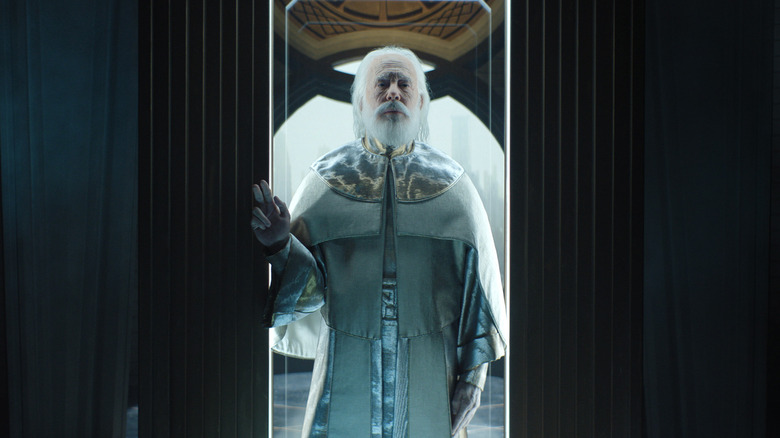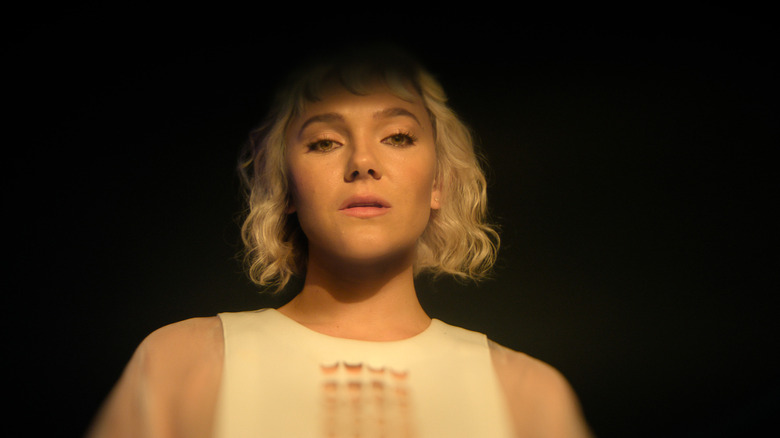Foundation Season 3's Biggest Villains Were Hiding In Plain Sight All Along
Please respect and enjoy the spoilers. This article discusses major plot details from the season 3 finale of "Foundation."
In a better world, the climactic episode of "Foundation" season 3 would've incited an online ruckus on par with some of the biggest and most divisive hours of "Game of Thrones." It's one thing to throw curveballs at viewers, shaking up the status quo by essentially taking a sledgehammer to the entire board. But it's quite another to do so in a way that keeps readers of the original Isaac Asimov books completely off balance, as well. Where most live-action adaptations tend to come with a certain sense of anticipation and inevitability among hardcore fans, "Foundation" diverged from the source material with as bold a creative choice (or, more accurately, two of them) as you'll ever see. When the smoke cleared, one thing became clear: We were paying attention to the wrong villain(s) the whole time.
For much of this year's storyline, we've spent an inordinate amount of screen time on two particularly powerful factions. Obviously, everything has revolved around the war-mongering Mule (Pilou Asbæk) in his quest to take over the galaxy and destroy Gaal Dornick (Lou Llobell) while he's at it. On the capital world of Trantor, meanwhile, we've been privy to the Empire's steady crumbling from within as all three Cleon clones fell prey to various acts of self-sabotage along the way. Taken together, it's been easy to imagine a straightforward path involving the downfall of the Genetic Dynasty, the Mule and Gaal's confrontation (as predicted in their visions), and a clear path to victory in accordance with Gaal and the Second Foundation's ambitious plan.
But in the span of just a few explosive set pieces, the real villains finally unmasked themselves for all to see — both of which were hiding in plain sight. While we assumed that the big Mule-related twist happened in last week's penultimate episode, the revelation that it was Bayta Mallow (Synnøve Karlsen) all along is one heck of a shocker. Not to be outdone, the double-whammy of Brother Dusk (Terrence Mann) finally going off the deep end in a desperate attempt to stave off his impending "ascension" helps make it all click into place. What we're left with is our heroes at their lowest point yet, two villains as powerful as ever, and a universe of possibilities ahead.
Foundation season 3 saves its biggest Mule twist for last
Bet you didn't see that coming, eh? Just when it seemed like Gaal and the Mule's much-hyped confrontation had ended in oddly abrupt fashion, the creative team decided to bowl us over with their most shocking move yet. The man we thought was the Mule from the very first scene of the season 3 premiere wasn't actually the Mule in the first place. After slitting her foe's throat in a gruesome mental tussle, Gaal realizes that the sinister presence in her mind hasn't gone away at all. The camera lingers on several possible suspects in the immediate vicinity: a suddenly sinister-looking Toran Mallow (Cody Fern), the befuddled researcher Ebling Mis (Alexander Siddig), and even everyone's favorite jester Magnifico (Tómas Lemarquis). But not until Bayta emerges from the shadows do we realize the full scope of this radical twist.
While the particulars of how Bayta could've been hiding this secret identity her whole life are left unanswered (she promises to explain it all to her lover Toran ... before promptly putting him to sleep), the emotional effect of this betrayal is fully in line with the original novella. Author Isaac Asimov's twist featured Magnifico unmasked by Bayta as the Mule himself, a clever disguise used to worm his way into the midst of his enemies and subtly manipulate their minds without suspicion. The show had plenty of fun toying with readers familiar with this development, but ultimately made the right call to keep the characters separate. Instead, the Bayta reveal preserves the chaos of that out-of-nowhere moment while instantly making the character much more fascinating. Our conception of the Mule instantly transforms from a typical warlord bent on conquest (which, while loads of fun, we've admittedly seen in "Game of Thrones" before) into a damaged woman operating from the shadows, using a much more palatable façade in public to keep the galaxy's eyes fixated far from herself.
Just by nature of fandom these days, this is bound to be a controversial choice; a deeper and fairer analysis beyond the surface, however, might make viewers appreciate a twist that's both rewarding and unexpectedly satisfying. Plus, this means Synnøve Karlsen gets to ham it up in full scenery-chewing mode next season now that she has nothing to hide. This is a win-win, folks.
Brother Dusk finally snaps ... and takes the Genetic Dynasty down with him
Elsewhere, on the other side of the galaxy, we now know why the season 3 finale was titled "The Darkness." Ever since its debut episode in 2021, the prophetic Hari Seldon (Jared Harris) lectured anyone who'd listen — and countless more who wouldn't — about the impending fall of Empire and the subsequent period of "darkness" that could very well spell the end of humanity as we know it. Thus, he enacted his centuries-spanning plan (involving the secretive Second Foundation) that would attempt to hasten that era of chaos and death, bringing the survivors through to the other side with only minimal losses. It was brilliantly engineered, mathematically precise, and ruthlessly efficient. A perfect course of action ... if only it could've anticipated the actions of a single motivated individual in a position of absolute power.
We all thought that fly in the ointment would be the Mule, but it turns out to have been the unlikeliest person imaginable. None other than Empire itself, Brother Dusk, would ultimately be responsible for bringing down his own Genetic Dynasty. In fairness, this secondary twist was actually set in motion right from the season's very first episode. When we first meet this version of Brother Dusk in the season 3 premiere, he's busy obsessing over hologram recordings of his predecessors when the time came for their own "ascension" — a ritualistic death march when the time comes for the eldest Cleon clone to make way for the youngest, the newly-decanted Brother Dawn. This foreshadowed the choice the latest (and, as it turns out, possibly last) Brother Dusk would make in his obsession to outrun death. Instead of either option, he blows up every clone currently in stasis, tricks the ever-loyal robot Demerzel (Laura Birn) into sacrificing her own life, and murders Brother Day (Lee Pace) for good measure. He even openly accepts his fulfillment of Seldon's prophecy, gleefully reflecting on tearing down Cleon I's epic Genetic Dynasty and leaving the Empire teetering over the most precarious edge imaginable.
With Brother Dusk now in charge, in possession of Hari's all-seeing and future-predicting Prime Radiant, there's no telling what havoc he may wreak. Combined with the Mule now fully let off her chain, season 4 could be the wildest one yet.
Season 3 of "Foundation" is streaming in its entirety on Apple TV+, and a fourth season received an official greenlight this week.


